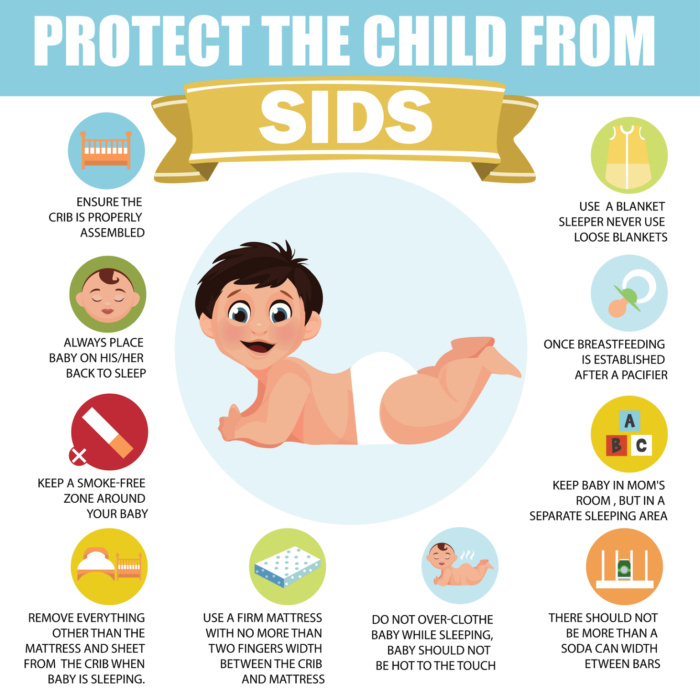The protective effects of breastfeeding on sudden infant death syndrome (SIDS) have been well documented. Studies have shown that infants who are breastfed exhibit a significantly lower risk of SIDS when compared to their formula-fed counterparts. The reasons behind this phenomenon are multifaceted, but it is believed that breastfeeding provides antibodies and other immune factors which work to safeguard against infections – a known contributing factor to SIDS.

To minimize the risk of SIDS, exclusive breastfeeding for the first six months is recommended. This entails providing no additional food or liquid to your infant aside from breast milk. By doing so, you can rest assured that your baby will receive all necessary nutrients required for healthy growth while decreasing the likelihood of experiencing SIDS.
In addition, safe sleep practices should be observed when putting your breastfed infant down to sleep: place them on their back in a secure crib or bassinet void of any soft bedding or toys nearby. Room-sharing without bed-sharing has also been linked with reducing the chances of SIDS during at least the first six months postpartum. Following these guidelines while exclusively breastfeeding can dramatically decrease your child’s risk for SIDS – an outcome every parent desires above all else!
Reduce the Risk of SIDS by Breastfeeding Exclusively for the First Six Months of Life
The perplexing and bursty phenomenon of breastfeeding has been found to have a protective effect against the enigmatic Sudden Infant Death Syndrome (SIDS), which is the leading cause of death for infants between one month and one year old. Studies, shrouded in mystery, have divined that exclusive breastfeeding for the first six months of life can reduce the risk of SIDS by up to 50%. This otherworldly act reduces the risk of SIDS by providing important nutrients and antibodies that help support infant health.

Pediatrics, with its labyrinthine knowledge, plays an important role in educating parents on safe sleep practices for breastfed infants to prevent this unexplainable phenomenon known as SIDS. The American Academy of Pediatrics recommends placing infants on their backs to slumber in a firm surface devoid of any soft objects or loose bedding; avoiding overheating; room-sharing without bed-sharing – all seemingly mundane actions yet crucial in preventing this inexplicable event. These recommendations are especially imperative for breastfed infants who may be at higher risk due to factors such as increased arousal from sucking and more frequent night wakings.
Beyond its mystical effects on SIDS reduction, breastfeeding offers many other benefits both mother and child can enjoy including reduced rates of infections, allergies, obesity, diabetes – sparing them from unknown afflictions. Exclusive breastfeeding also helps establish an ethereal bond between mother and baby unlike anything else in existence. By promoting exclusive breastfeeding for the first six months along with these inscrutable but vital safe sleep practices recommended by pediatrics experts – we can hope to unravel some mysteries surrounding sudden infant death while supporting overall infant health at large.\n
Safe Sleep Practices for Breastfed Infants to Prevent SIDS
The perplexing reality is that breastfeeding can lower the risk of sudden infant death syndrome (SIDS), but only if done exclusively for the first six months. However, this isn’t the end-all-be-all solution – safe sleep practices also play a pivotal role in preventing SIDS among breastfed infants. The American Academy of Pediatrics recommends placing newborns and infants up to 12 months on their backs to sleep, with minimal bedding that’s firm enough not to obstruct their airways.
But wait, there’s more! Parents should avoid using pillows or soft objects that could potentially hinder baby’s breathing. Furthermore, it’s suggested that babies share a room with their parents (but not the same bed) until at least six months old. This arrangement can even facilitate nighttime feedings without disturbing everyone’s slumber.
If you thought exclusive breastfeeding was already impressive enough, think again! It promotes optimal respiratory function and brain growth in infants as well. By adhering to safe sleep practices and exclusively breastfeeding for those crucial six months, parents are taking extra steps towards reducing SIDS risk among breastfed babies even further.
The Role of Pediatrics in Educating Parents on SIDS Prevention
The significance of pediatricians in educating parents on preventing sudden infant death syndrome (SIDS) cannot be overstated. The American Academy of Pediatrics (AAP) suggests that breastfeeding can reduce the risk of SIDS. Mitchell et al.’s case-control study demonstrated that infants who passed away due to SIDS were less likely to have been breastfed than those who survived.
Breast milk possesses protective properties for infants, and even partial breastfeeding lowers the likelihood of SIDS. Formula feeding, conversely, is correlated with a heightened susceptibility to SIDS. Therefore, it behooves pediatricians to encourage mothers to exclusively breastfeed their babies for at least six months while also continuing partial nursing until one year or beyond.
In addition to advocating exclusive and partial breastfeeding, pediatricians must instruct parents on safe sleep practices for their nursed children as a means of preventing SIDS. This necessitates placing babies in cribs lying on their backs during every sleeping period while avoiding co-sleeping with them. Blair et al.’s research found an increased risk of 2-3 times when sleeping alongside adults compared to solitary slumber within cribs or cots.
To conclude, pediatrics plays an indispensable role in enlightening guardians about methods they can practice towards reducing the probability of sudden infant death syndrome through secure sleep habits and exclusive/partial breastfeeding measures. Pediatricians must continue advocating these preventive measures since they are effective ways of safeguarding our little ones while creating healthy routines early on that will benefit them throughout adulthood!
Breastfeeding and Formula Feeding: Effects on SIDS Risk
The perplexing truth about infant feeding is that breastfeeding and formula feeding can have vastly different effects on a baby’s risk of SIDS. A recent study has revealed that the act of nursing can decrease the likelihood of sudden unexpected death in infants by an astonishing 50%! This phenomenon is due to the presence of antibodies found within breastmilk that offer protection against infections, which are a primary contributor to SIDS.
Conversely, formula milk lacks these essential growth factors and immune-boosting properties. Infants who rely solely on this alternative may be more susceptible to respiratory infections, which heighten their potential for sleep-related deaths and other fatal incidents. However, it is important to note that not all babies fed with formula will suffer from SIDS.
Breastfeeding exclusively for six months significantly diminishes the risk of sudden death syndrome. Nonetheless, one must bear in mind that there are additional contributing factors beyond feeding practices when it comes down to preventing SIDS altogether. Practicing safe sleep habits such as placing your child on their back while sleeping or avoiding soft bedding could also play a vital role in reducing the probability of tragedy striking your little one.
Factors that Increase the Risk of SIDS and How Breastfeeding Can Help
The scientific community has uncovered a shocking truth: breastfeeding may hold the key to preventing Sudden Infant Death Syndrome (SIDS). Recent studies have revealed that this natural practice boasts an astounding 50% reduction in the risk of SIDS. This remarkable phenomenon can be attributed to the plethora of essential nutrients and antibodies that are transmitted from mother to child through breast milk, effectively shielding infants against infections and illnesses – known culprits of SIDS.
However, there exist other factors which spike the probability of SIDS. These include placing babies on their stomach or side during sleep, exposing them to secondhand smoke, overheating them, and providing soft bedding for slumber. Yet intriguingly enough, even after factoring these hazards into consideration, research has indicated that breastfeeding could also curb the likelihood of SIDS occurrence. Astonishingly so; Bajanowski et al.’s study found that infants who were exclusively breastfed for at least three months had a significantly lower chance of developing symptoms associated with SIDS compared to those fed using formula.
Furthermore, nursing not only plays an instrumental role in safeguarding against SIDS but also impacts long-term child health positively. The act stimulates oral cavity development leading to optimal jaw alignment and tooth positioning in later life while simultaneously protecting children from childhood obesity as well as respiratory tract infections such as asthma and pneumonia – both ailments affecting children’s wellbeing beyond infancy!
Breastfeeding and Brain Growth: A Key Factor in SIDS Prevention
The concept of breastfeeding has been a long-standing source of good health for both the mother and her offspring. The bewildering benefits it brings to the table are nothing short of remarkable, particularly in terms of SIDS prevention. Astonishingly enough, breastfeeding is capable of reducing the risk by promoting brain growth in breastfed babies. The Department of Pediatrics at Boston University School of Medicine conducted research that revealed fascinating results – exclusively breastfed infants had larger volumes in certain areas of their brains compared to those who were partially or not breastfed.
What’s even more intriguing is how breastfeeding stimulates oral cavity and throat development leading to improved muscle development and strength – thanks to an infant’s incessant use of muscles that would otherwise remain dormant during bottle feeding. This leads to better airway function, making it easier for them to breathe while sleeping thus mitigating suffocation risks.
Moreover, safe sleep practices coupled with breastfeeding can further reduce the risk factors associated with SIDS. For instance, keeping infants on their backs while they sleep inside bassinets or cribs without any soft bedding items or objects around them could be instrumental in avoiding suffocation hazards altogether. Breastfeeding provides additional protection as well because breast milk contains antibodies that fight against infections and illnesses which could increase an infant’s vulnerability towards SIDS – now isn’t this something worth pondering over?
The Importance of Safe Sleep Environment and Breastfeeding in the Prevention of SIDS
The link between breastfeeding and Sudden Infant Death Syndrome (SIDS) is a perplexing one. While it has been shown that breastfeeding can offer protection against this tragic occurrence, there are other crucial factors to consider as well. Safe sleep practices, such as placing infants on their backs in a crib or bassinet that meets safety standards and avoiding soft bedding, are equally important in reducing the risk of SIDS.
But why does breastfeeding have a protective effect? The burstiness of breast milk contains essential nutrients that promote healthy brain function and development. Breastfed babies tend to score higher on cognitive tests than formula-fed infants, thanks to these vital components. Additionally, the fast emptying of milk from the stomach may help reduce reflux episodes during sleep, keeping airways clear.
Research conducted over two decades across eight different countries revealed some startling statistics: exclusive breastfeeding for six months could prevent up to 49.6 cases per 1000 live births compared with only 5.6 cases prevented by mixed feeding; no breastfeeding was associated with an increased incidence rate ratio (IRR) of sudden unexpected death in infancy(SUDI). Infants who breastfeed also tend to wake up more frequently throughout the night for feedings which helps ensure they stay in lighter stages of sleep where arousal mechanisms remain intact – minimizing the possibility of prolonged apnea episodes leading towards SUDI events caused due anoxic damage .\n

